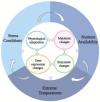Cold adapted Pseudomonas: ecology to biotechnology
- PMID: 37529326
- PMCID: PMC10388556
- DOI: 10.3389/fmicb.2023.1218708
Cold adapted Pseudomonas: ecology to biotechnology
Abstract
The cold adapted microorganisms, psychrophiles/psychrotolerants, go through several modifications at cellular and biochemical levels to alleviate the influence of low temperature stress conditions. The low temperature environments depend on these cold adapted microorganisms for various ecological processes. The ability of the microorganisms to function in cold environments depends on the strategies directly associated with cell metabolism, physicochemical constrains, and stress factors. Pseudomonas is one among such group of microorganisms which is predominant in cold environments with a wide range of ecological and biotechnological applications. Bioformulations of Pseudomonas spp., possessing plant growth promotion and biocontrol abilities for application under low temperature environments, are well documented. Further, recent advances in high throughput sequencing provide essential information regarding the prevalence of Pseudomonas in rhizospheres and their role in plant health. Cold adapted species of Pseudomonas are also getting recognition for their potential in biodegradation and bioremediation of environmental contaminants. Production of enzymes and bioactive compounds (primarily as an adaptation mechanism) gives way to their applications in various industries. Exopolysaccharides and various biotechnologically important enzymes, produced by cold adapted species of Pseudomonas, are making their way in food, textiles, and pharmaceuticals. The present review, therefore, aims to summarize the functional versatility of Pseudomonas with particular reference to its peculiarities along with the ecological and biotechnological applications.
Keywords: Pseudomonas; adaptation; biotechnological applications; ecological processes; psychrophiles.
Copyright © 2023 Chauhan, Kimothi, Sharma and Pandey.
Conflict of interest statement
The authors declare that the research was conducted in the absence of any commercial or financial relationships that could be construed as a potential conflict of interest.
Figures
References
-
- Afonso L., de Lima Andreata M. F., Chryssafidis A. L., Alarcon S. F., das Neves A. P., da Silva J. V. F. R., et al. (2022). Fluopsin C: a review of the antimicrobial activity against phytopathogens. Agronomy 12:2997. doi: 10.3390/agronomy12122997 - DOI
-
- Ahn E., Choi K. Y., Kang B. S., Zylstra G. J., Kim D., Kim E. (2017). Salicylate degradation by a cold-adapted Pseudomonas sp. Ann. Microbiol. 67, 417–424. doi: 10.1007/s13213-017-1273-3 - DOI
-
- Allen C. C. R., Boyd D. R., Dalton H. (2000). Process for the resolution in cis 1,2- indane diols using Pseudomonas putida. US Patent No. 6165777. London: Zeneca limited.
Publication types
LinkOut - more resources
Full Text Sources
Miscellaneous




